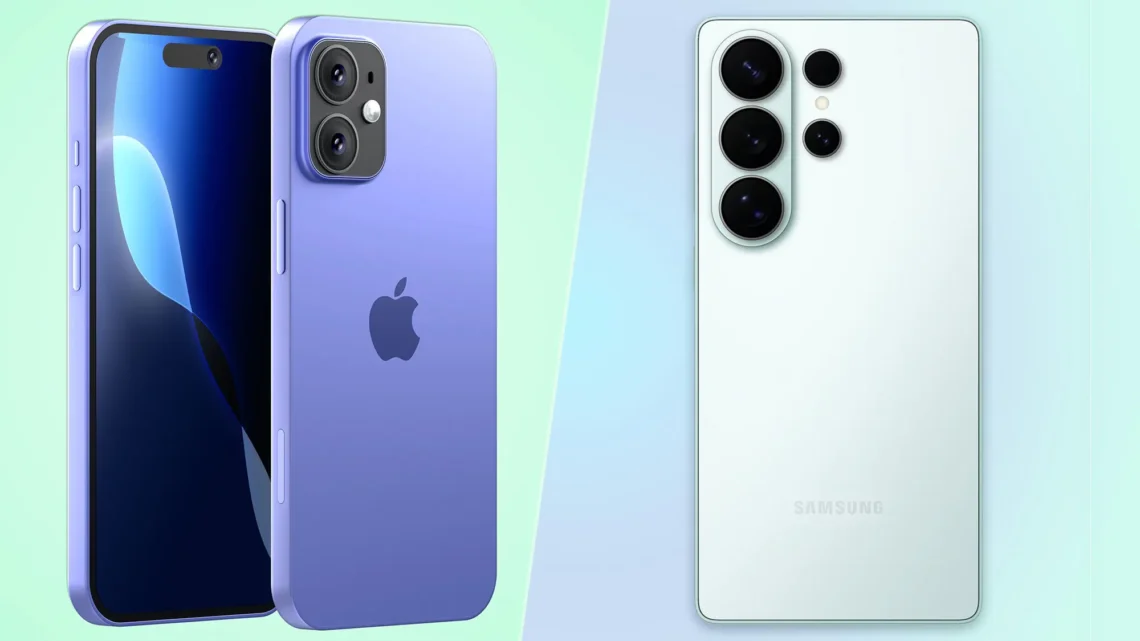
iPhone 17 vs Samsung Galaxy S26: Which Flagship Wins?
As we step into 2026, the battle for the best flagship smartphone intensifies with Apple’s iPhone 17 lineup—launched in September 2025—and Samsung’s Galaxy S26 series, expected to debut in January or February.
These devices represent the pinnacle of mobile innovation, blending cutting-edge performance, stunning displays, and AI-driven features into premium packages.
Trending Now!!:
Whether you’re upgrading from an older model or debating your next big purchase, comparing the iPhone 17 and Galaxy S26 reveals key differences in design philosophy, power, and user experience.
Let’s dive into the details to see which one claims the crown as the ultimate flagship smartphone of the year.
Design and Build: Sleek Innovation Meets Rugged Reliability
The iPhone 17 series by Apple continues its tradition of premium, minimalist aesthetics, with the base iPhone 17 sporting a refined aluminium unibody that’s both lightweight and durable.
At around 6.3 inches, it features ultra-thin bezels and Ceramic Shield glass on both front and back for superior scratch and impact resistance.
The lineup introduces the iPhone 17 Air, an ultra-thin variant at just 5.5mm thick, emphasizing portability without sacrificing too much battery life—though its 2,800mAh capacity is a trade-off for that slim profile. Pro models like the iPhone 17 Pro Max add a titanium frame and a horizontal camera bar, enhancing grip while maintaining IP68 water and dust resistance.
Samsung’s Galaxy S26 counters with a focus on versatility and slimness across the board. The base Galaxy S26 (potentially rebranded as S26 Pro) measures about 6.27 inches with a flat-edged design reminiscent of recent iPhones, but it introduces Qi2 magnetic wireless charging for seamless accessory integration.
The Galaxy S26 Edge steals the show as Samsung’s thinnest flagship yet at under 6mm, competing directly with the iPhone 17 Air while packing a 4,200-4,400mAh battery. The S26 Ultra, at 6.9 inches, refines its titanium build to under 8mm thick with rounded corners for better one-handed use, and it retains an IP68 (or possibly IP69K) rating.
Both brands prioritize sustainability with recycled materials, but Samsung edges out in modularity with expandable storage rumors and the retained S Pen stylus on the Ultra.
In this flagship smartphone showdown, the iPhone 17 feels more polished for everyday elegance, while the Galaxy S26 lineup offers bolder options for users craving customization.
Display: Vibrant Screens for Immersive Viewing
Nothing defines a top-tier flagship smartphone like its screen, and both the iPhone 17 and Galaxy S26 deliver jaw-dropping visuals.
Apple’s iPhone 17 boasts a 6.3-inch Super Retina XDR OLED panel with ProMotion technology, ramping up to a 120Hz refresh rate for buttery-smooth scrolling—now extended across the entire lineup, including the base model.
Peak brightness hits 2,000 nits for HDR content, and anti-reflective coatings reduce glare in bright environments. The iPhone 17 Pro Max ups the ante with a 6.9-inch display reaching 3,000 nits, supporting always-on functionality and Dynamic Island for intuitive notifications.
Samsung’s Galaxy S26 series shines with Dynamic AMOLED 2X technology, as the base model features a slightly larger 6.27-inch screen at 144Hz for even fluid animations.
The S26 Ultra’s 6.9-inch panel pushes boundaries with 3,000 nits brightness and rumoured “Flex Magic” privacy filters that limit side-angle visibility—perfect for public commutes. All models include under-display fingerprint sensors, contrasting Apple’s Face ID, and Samsung’s Gorilla Glass Victus 3 promises enhanced drop protection.
For media consumption, the Galaxy S26’s higher refresh rate and privacy perks make it a slight winner, but the iPhone 17’s colour accuracy and ecosystem integration keep it competitive in the race for the best smartphone display of 2026.
Performance and Software: Powerhouses Fueled by AI
Under the hood, these flagships are beasts. The iPhone 17 runs on Apple’s A19 chip, fabricated on a 3nm process for a 25% performance boost over the A18, enabling seamless multitasking, advanced Apple Intelligence features like enhanced Siri, and on-device machine learning.
Paired with 8GB of RAM (up to 12GB on Pro models), it handles gaming and video editing effortlessly, with iOS 19 offering seven years of updates for longevity.
The Galaxy S26 leverages the Snapdragon 8 Elite Gen 5 (or Exynos 2600 in some regions), clocking up to 4.6GHz with over 16GB of RAM for superior multi-core prowess—rumoured to outpace the A19 in benchmarks like AnTuTu by a wide margin.
Samsung’s One UI 8 on Android 16 integrates Galaxy AI deeply, with partnerships like Perplexity for advanced assistants and real-time translation. Expect vapor chamber cooling on the Ultra for sustained gaming, and features like stacked batteries for efficiency.
If raw power is your priority, the Galaxy S26 pulls ahead as the performance king among 2026 flagships, but Apple’s optimized ecosystem makes the iPhone 17 feel snappier for daily tasks.
Camera Systems: Capturing Moments with Precision
Photography remains a flagship staple, and both shine here. The iPhone 17’s triple 48MP setup—main, ultra-wide, and telephoto—delivers natural colors and 8x optical zoom on Pro models, with a 24MP front camera for sharper selfies.
New ProRes RAW and Apple Log 2 cater to creators, while computational photography excels in low light. Samsung’s Galaxy S26 Ultra boasts a 200MP main sensor with variable aperture rumours, paired with a 50MP ultra-wide and dual telephotos (10MP 3x and 50MP 5x) for versatile zoom.
The base S26 gets modest upgrades to 50MP rear cams, emphasizing AI enhancements like real-time object removal. Video hits 8K with Dolby Vision, outpacing Apple’s 4K focus.
For pros, the Galaxy S26 Ultra’s zoom versatility wins, but the iPhone 17’s consistent, user-friendly results make it ideal for casual shooters seeking the best smartphone camera in everyday scenarios.
Battery Life and Charging: All-Day Endurance
Battery anxiety is a thing of the past with these devices. The iPhone 17’s 3,500mAh cell (up to 5,000mAh on Pro Max) benefits from A19 efficiency, lasting 18+ hours of mixed use, with 20W MagSafe wireless and 30W wired charging. Satellite SOS extends off-grid reliability.
The Galaxy S26 matches with a 4,300mAh base battery (5,000mAh on Ultra), potentially using silicon-carbon tech for longer life despite slimmer builds. It supports 45W wired and 15W wireless, with reverse charging for accessories.
The iPhone 17 edges in real-world efficiency, but the Galaxy S26’s faster charging appeals to on-the-go users.
| Feature | iPhone 17 (Base/Pro Max) | Galaxy S26 (Base/Ultra) |
|---|---|---|
| Battery Capacity | 3,500mAh / 5,000mAh | 4,300mAh / 5,000mAh |
| Wired Charging | 30W | 45W |
| Wireless Charging | 20W MagSafe | 15W Qi2 |
| Endurance (Mixed Use) | 18-20 hours | 17-19 hours |
Price and Availability: Value in the Premium Segment
Starting at $799 for the base iPhone 17 and $1,199 for the Pro Max, Apple’s pricing reflects its ecosystem lock-in.
The Galaxy S26 begins at $799 (S26 Pro rumors), climbing to $1,299 for the Ultra—potentially higher due to tariffs. Pre-orders for iPhone 17 hit September 2025, while Galaxy S26 arrives early 2026.
Verdict: Which Flagship Smartphone Wins?
In the iPhone 17 vs Samsung Galaxy S26 rivalry, there’s no outright victor—it boils down to your needs. The iPhone 17 triumphs for seamless integration, privacy-focused AI, and reliable cameras, making it the best iOS flagship smartphone for Apple loyalists.
Conversely, the Galaxy S26 excels in raw power, display innovation, and customization, positioning it as the top Android flagship for versatility seekers.
If you’re chasing the ultimate 2026 flagship smartphone, go iPhone 17 for polished simplicity or Galaxy S26 for boundary-pushing features. Either way, you’re holding a piece of the future.


